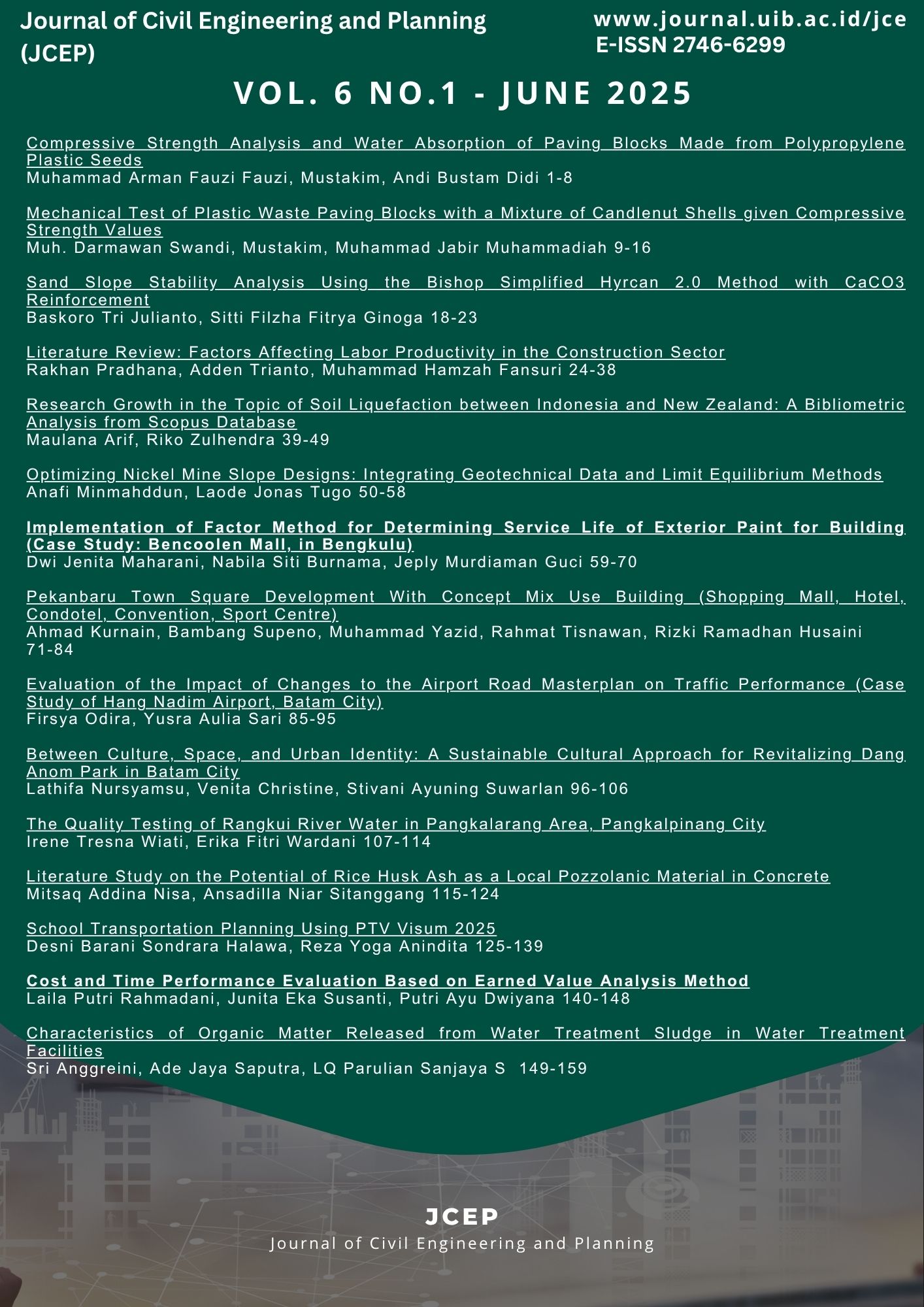Characteristics of Organic Matter Released from Water Treatment Sludge in Water Treatment Facilities
DOI:
https://doi.org/10.37253/jcep.v6i1.10441Keywords:
organic matter, water treatment sludge, incubation, anoxic, oxicAbstract
Water treatment sludge (WTS) generated from water treatment plants (WTPs) contains organic matter (OM) that may be released during storage prior to the dewatering process due to the influence of temperature and oxygen. The release of OM from WTS can deteriorate the quality of treated water if the dewatering effluent is recycled back into the WTP system. This study aims to investigate changes in the quality of OM in WTS during storage under varying temperatures (20°C and 40°C) and oxygen conditions (oxic and anoxic). The characteristics of released OM were evaluated by measuring dissolved organic carbon (DOC), ultraviolet absorbance at 260 nm (UV260), and fluorescence Excitation-Emission Matrix (EEM). The Specific UV Absorbance (SUVA) parameter was also calculated to assess the aromatic content of OM. The highest DOC concentration (4.94 mg/L) was observed under anoxic conditions at 40°C, which was 4.3 times higher than the lowest value found under oxic conditions at 20°C (1.14 mg/L). The highest UV260 absorbance (13.55 m⁻¹) and SUVA value (2.74 m⁻¹/(mg/L)) were also found under the anoxic 40°C condition, indicating a dominance of aromatic and humic-like substances formed during storage. EEM fluorescence analysis detected three main peaks representing protein-like, fulvic acid-like, and humic acid-like substances. Fulvic and humic acid-like substances were released more abundantly under anoxic conditions compared to protein-like substances. Differences in oxygen and temperature conditions play a significant role in determining the characteristics of OM released from WTS.
Downloads
References
[1] Y. Qian, Y. Chen, Y.Hu, D. Hanigan, P. Westerhoff, D. An, ”Formation and control of C- and N-DBPs during disinfection of filter backwash and sedimentation sludge water in drinking water treatment,” Water Res., vol. 194, pp. 116964, 2021, doi: https://doi.org/10.1016/j.watres.2021.116964.
[2] Y. Hu, Y. Qian, Y. Chen, J. Guo, J. Song, D. An, “Characteristics of trihalomethane and haloacetic acid precursors in filter backwash and sedimentation sludge waters during drinking water treatment,” Sci. Total Environ., vol. 775, pp. 145952, 2021, doi: https://doi.org/10.1016/j.scitotenv.2021.145952.
[3] Z. Liu, Y. Xu, X. Yang, R. Huang, Q. Zhou, F. Cui, “Does the recycling of waste streams from drinking water treatment plants worsen the quality of finished water? A case assessment in China,” Water Supply, vol. 17, no. 2, pp. 597–605, 2016, doi: https://doi.org/10.2166/ws.2016.151.
[4] H. Du, F. Li, “Characteristics of dissolved organic matter formed in aerobic and anaerobic digestion of excess activated sludge,” Chemosphere, vol. 168, pp. 1022–1031, 2017, doi: https://doi.org/10.1016/j.chemosphere.2016.10.108.
[5] K. Komatsu, T. Onodera, A. Kohzu, K. Syutsubo, A. Imai, “Characterization of dissolved organic matter in wastewater during aerobic, anaerobic, and anoxic treatment processes by molecular size and fluorescence analyses,” Water Res., vol. 171, pp. 115459, 2020, doi: https://doi.org/10.1016/j.watres.2019.115459.
[6] Y.A. Sari, A.I. Rifai, “Innovative Solutions for Sewage using Food Chain Reaction (FCR) in Indonesia,” J. Phys.: Conf. Ser., vol. 1655, pp. 012117, 2020, doi: https://doi.org/10.1088/1742-6596/1655/1/012117.
[7] Y.A. Sari, A.I. Rifai, “Current Situation of Wastewater Treatment Plant for Sewage in Batam City,” J. Phys.: Conf. Ser., vol. 1351, pp. 012109, 2019, doi: https://doi.org/10.1088/1742-6596/1351/1/012109.
[8] I. Indrastuti, A. Andriawan, L. Leany, “Analisis Waste Water Management pada Proyek Pembangunan Mega Super Blok Meisterstadt Batam Centre,” Journal of Civil Engineering and Planning, vol. 2, no. 2, pp.
180-187, 2021, doi: https://doi.org/10.37253/jcep.v2i2.731.
[9] A.R. Hidayat, M.K. Ilmi, “Study of Drinking Water Supply System Development Planning in Dusun Tuti, North Lombok Regency, Indonesia,” vol. 4, no. 2, pp. 211-226, 2023, doi: https://doi.org/10.37253/jcep.v4i2.8811.
[10] Y. Qian, Y. Hu, Y. Chen, D. An, P. Westerhoff, D. Hanigan, W. Chu, “Haloacetonitriles and haloacetamides precursors in filter backwash and sedimentation sludge water during drinking water treatment,” Water Res., vol. 186, pp. 116346, 2020, doi: https://doi.org/10.1016/j.watres.2020.116346.
[11] Z. Zhou, Y. Yang, X. Li, Y. Zhang, X. Guo, “Characterization of drinking water treatment sludge after ultrasound treatment,” Ultrason. Sonochem, vol. 24, pp. 19–26, 2015, doi: https://doi.org/10.1016/j.ultsonch.2014.11.007.
[12] T. Ahmad, K. Ahmad, M. Alam, “Characterization of Water Treatment Plant’s Sludge and its Safe Disposal Options,” Procedia Environ. Sci., vol. 35, pp. 950–955, 2016, doi: https://doi.org/10.1016/j.proenv.2016.07.088.
[13] M. Sillanpää, M. C. Ncibi, A. Matilainen, M. Vepsäläinen, “Removal of natural organic matter in drinking water treatment by coagulation: A comprehensive review,” Chemosphere, vol. 190, pp. 54-71, 2018, doi: https://doi.org/10.1016/j.chemosphere.2017.09.113.
[14] M. Zeeshan, V. Ingold, L. Saal, C. Hora, A. Kampfe, A.S. Ruhl, “Compositions and concentrations of dissolved organic matter, selected elements and anions in German drinking waters,” J. Environ. Manag., vol. 376, pp. 124459, 2025, doi: https://doi.org/10.1016/j.jenvman.2025.124459.
[15] W. Tang, L. Sun, Y. Zhu, J.C. Ng, J. Huang, Z. Xu, H. Zhang, “Difference analysis of organic matter-mediated heavy metal pollution in the sediments of urban water bodies,” Sci. Total Environ., vol. 968, pp. 178747, 2025, doi: https://doi.org/10.1016/j.scitotenv.2025.178747.
[16] L.E. Anderson, I. DeMont, D.D. Dunnington, P. Bjorndahl, D.J. Radden, M.J. Brophy, G.A. Gagnon, “A review of long-term change in surface water natural organic matter concentration in the northern hemisphere and the implications for drinking water treatment,” Sci. Total Environ., vol. 858, pp. 159699, 2023, doi: https://doi.org/10.1016/j.scitotenv.2022.159699.
[17] L. Zeng, Z. Zhou, J. Zhang, C. Wang, C. Fang, X. Ren, M. Xiang, S. Chen, H. Li, “Selective degradation of organic pollutants in the aquatic environment by microplastic-derived dissolved organic matter through molecular photoresponse sequence transformation,” J. Chem. Eng., vol. 499, pp. 156676, 2024, doi: https://doi.org/10.1016/j.cej.2024.156676.
[18] M. Derrien, S.R. Brogi, R. Gonçalves-Araujo, “Characterization of aquatic organic matter: Assessment, perspectives and research priorities,” Water Res., vol. 163, pp. 114908, 2019, doi: https://doi.org/10.1016/j.watres.2019.114908.
[19] E. Lipczynska-Kochany, “Humic substances, their microbial interactions and effects on biological transformations of organic pollutants in water and soil: A review,” Chemosphere, vol. 202, pp. 420-437, 2018, doi: https://doi.org/10.1016/j.chemosphere.2018.03.104.
[20] E. Lipczynska-Kochany, “Effect of climate change on humic substances and associated impacts on the quality of surface water and groundwater: A review,” Sci. Total Environ., vol. 640-641, pp. 1548-1565, 2018, doi: https://doi.org/10.1016/j.scitotenv.2018.05.376.
[21] Y. Wang, H. Xu, Z. Shen, C. Liu, M. Ding, T. Lin, H. Tao, W. Chen, “Variation of carbonaceous disinfectants by-products precursors and their correlation with molecular characteristics of dissolved organic matter and microbial communities in a raw water distribution system,” Chemosphere, vol. 283, pp. 131180, doi: https://doi.org/10.1016/j.chemosphere.2021.131180.
[22] L.-C. Hua, S.-J. Chao, K. Huang, C. Huang, “Characteristics of low and high SUVA precursors: Relationships among molecular weight, fluorescence, and chemical composition with DBP formation,” Sci. Total Environ., vol. 727, pp. 138638, doi: https://doi.org/10.1016/j.scitotenv.2020.138638.
[23] F.J. Rodríguez-Vidal, M. García-Valverde, B. Ortega-Azabache, A. González-Martínez, A. Bellido-Fernándezb, “Using excitation-emission matrix fluorescence to evaluate the performance of water treatment plants for dissolved organic matter removal. Spectrochimica Acta Part A, vol. 249, pp. 119298, doi: https://doi.org/10.1016/j.saa.2020.119298.
[24] L. Pang, J. Ni, X. Tang, “Fast Characterization of soluble organic intermediates and integrity of microbial cells in the process of alkaline anaerobic fermentation of waste activated sludge,” Biochem. Eng. J., vol. 86, pp. 49–56, doi: https://doi.org/10.1016/j.bej.2014.03.005.
[25] P. Nannipieri, G. Angst, C. Mueller, G. Pietramellara, “The role of death and lysis of microbial and plant cells in the formation of soil organic matter,” Soil Biol. Biochem., vol. 204, pp. 109750, 2025, doi: https://doi.org/10.1016/j.soilbio.2025.109750.
Downloads
Published
Issue
Section
License
Copyright (c) 2025 Sri Anggreini, Ade Jaya Saputra, LQ Parulian Sanjaya S

This work is licensed under a Creative Commons Attribution 4.0 International License.



_0011.jpg)









